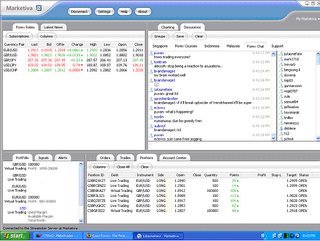What is a PIPS?
In the Forex market, prices are quoted in pips. Pip stands for "percentage in point" and is the fourth decimal point, which is 1/100th of 1%.
In EURO/USD, a 3 pip spread is quoted as 1.2500/1.2503
Among the major currencies, the only exception to that rule is the Japanese yen. In USD/JPY, the quotation is only taken out to two decimal points (i.e. to 1/100 th of yen, as opposed to 1/1000th with other major currencies).
In USD/JPY, a 3 pip spread is quoted as 114.05/114.08
PIPS also shows how much u earn and loss at the realtime of your trading.As my advise to newbies in FOREX just stick to 5-10 pips closing per trade.This will slowly build up your confident level to target more pips next time.Most of the great trader will targeting 50 over pips.Sometimes can catch more than 100 over pips depend on how wise their trading skills and system.
Basic things u must know before opening any trade; what is BUY and SELL. Open BUY position if u think (depend on chart and system u use) the pair price will go up while open SELL position if u think the pair price will go down. Some broker allow trader to open BUY and SELL at the same time.This up and down price was tremendously rocking like crazy after big news was released.Be carefull to trade using news as we could not expect how much the impact will hit our trading.
The BIG Trading Factors
The importance of economic data releases and government events will depend on the current market's focus. For example, trade data have been important in the past, but are basically ignored right now. Since the U.S Federal Reserve has steadily been raising interest rates for the past year, interest rates and inflation reports have been in the spotlight. The market focus constantly changes so its important that you're aware of what the "it" factor is at the moment.
There are the top factors that have a major market impact on a regular basis:
* US employment data
* FOMC meetings
* US Federal Reserve Chairman's testimoy
* US trade balance
* US GDP
* ECB rate decisions
* US Consumer Price Index
* US retail sales
* Japan Tankan Index



